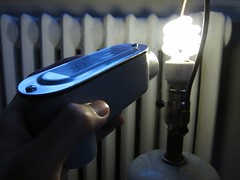You'll notice that many spectra on [Spectral Workbench](https://spectralworkbench.org) have a scale showing "nm" or nanometer units on the horizontal axis. To get scaled data, you must calibrate your spectrometer. There are several kinds of calibration but here we're talking about wavelength calibration, which allows your spectrometer to display a wavelength value for any color of light it sees. Luckily, this is easy.
1) Find a **fluorescent light bulb** -- preferably a compact fluorescent bulb you can put your spectrometer very close to. Point your spectrometer at the bulb -- if it's too bright, point it at a piece of white paper or wall which is brightly illuminated by the bulb.
 
2) You'll see an image like the above example; if you're on a computer, it may appear horizontally. The lines you see are from mercury in the bulb, and since we know what wavelengths they **should** be, we can use this to calibrate your device.
Save this spectrum, and tag it "fluorescent" and/or "CFL". Now you'll need to use the analysis tool to calibrate; it will walk you through the process.
###Calibrating using your fluorescent bulb spectrum###
You can calibrate your spectra or your spectrometer because the spectrum of a compact fluorescent light bulb is well known. Two lines in particular are very stable and easy to recognize:
* **Mercury 2 line:** "middle blue line" at 435.833 nanometers
* **Mercury 3 line:** "bright green line" at 546.074 nanometers
Click the **Calibrate** button and you'll be guided through identifying and clicking on each of these lines. Once you've calibrated a single spectrum, you'll be able to apply that calibration to all of the spectra you collected with that instrument.
Watch this video for a walkthrough of the whole process:
##Known issues##
There is still a bug in the code that can cause odd calibration results -- Jeff needs to fix it (sorry!). Try pressing "re-extract" than after it clears the previous calibration, clicking "calibrate" again and following the instructions once more. Try comparing your calibration to another (search for "CFL calibration").
##Custom calibrations##
You can calibrate a spectrum with 2 known pixel positions and corresponding wavelength values with the following URL format:
> https://spectralworkbench.org/spectrums/calibrate/?x1=242&w1=554&x2=483&w2=780
Where is the ID of your spectrum, x1 and x2 are the pixel locations, and w1 and w2 are the wavelengths for those positions.